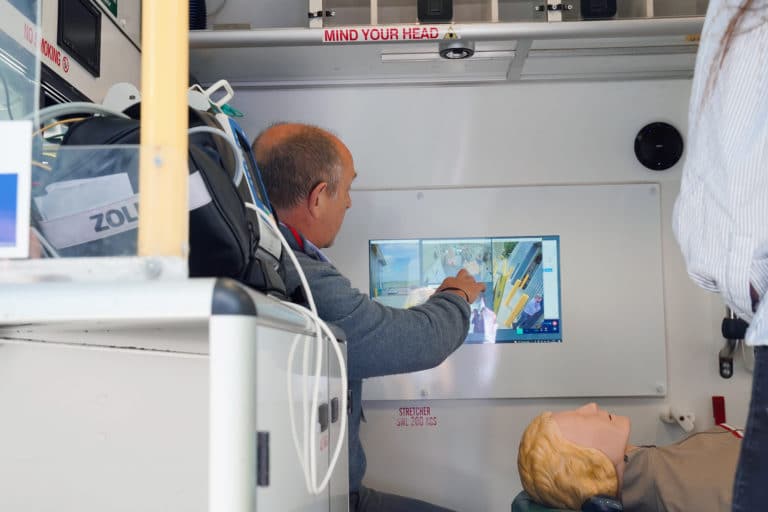No going back?
Visionable round table discusses how to maintain health tech momentum
Visionable organised a round table to give NHS digital leaders the opportunity to discuss some recent developments in health and care and what they mean for technology. Visionable advisors Rachel Dunscombe and Andy Kinnear outline some of the big issues that were discussed.
These are exciting times for healthcare technology; but they are uncertain times as well. The first wave of the coronavirus pandemic led an increased uptake in remote working and virtual consultation solutions; and confident assertions that there would be “no going back.”
Yet the health service is coming out of Covid-19 facing a huge waiting list, a financial crisis, and another round of reform. The government has published a white paper that will change the way the NHS is run, end the internal market, and create a legal foundation for the integrated care systems that will cover the whole of England by April.
Rachel Dunscombe, a former trust chief information officer and technology adviser to Visionable, says: “This is a seismic change; probably the biggest change for decades. It raises the question of what it all means for digital. What are the opportunities and the barriers to overcome? What should healthcare and industry be doing to address them?”
Covid breaks down barriers
A few days after a leak of the white paper made it into the press, Visionable organised a round table for NHS CIOs to discuss these issues. Andy Kinnear, another adviser to Visionable, says it started by focusing on how the pandemic had both highlighted barriers to digital adoption and dismantled them.
For example, he said that in his recent role as the leader of a shared care record in the South West, he had often come up against organisational barriers to information sharing. The Lansley reforms of 2012, which created a “fragmented” landscape of competing commissioners and providers, had been unable to overcome them.
But when Covid-19 hit, people had pulled together at system level. “Some of the organisational barriers were overcome,” he explains. “The single, unifying force of the response to Covid helped us to overcome them.”
No going back?
Round table participants wanted to keep the barriers down. So, they welcomed aspects of the white paper that might help to do this, such as its proposals to clarify the role of the centre, bolster strategic working at a regional level, encourage local collaboration, and reduce bureaucracy.
Participant insight: “We need to know who does what at a local, regional and national level. We need strong relationships at all levels. And please remember primary and social care!”
“I sometimes talk about the four engines of healthcare technology,” Kinnear says. “We have policy, national delivery, vendors, and local health and care delivery, and we need to get all of those lined up and driving the frontline, because that’s where change happens.
“The white paper will be good if it makes that happen.” There was also optimism about the potential of integrated care systems, which have evolved out of the NHS Long Term Plan and been given a clear brief to join up services and to shift to a population health management approach.
NHS England and Improvement has recognised that ICSs will need shared care records, data analytics, remote monitoring and digital patient services to do that, and its digital agency, NHSX, has set a target for every healthcare economy in England to have a ‘basic’ or ‘minimum viable solution’ shared care record by September.
Round table participants argued these developments could be transformative, if they bring about the kind of integrated care, underpinned by modern communications, that has been delivered in Denmark, some Nordic countries, and even integrated care pioneers in the UK.
Participant insight: “We also need to bring in economic development factors, to encourage investment in the local economy. The wider determinants of health need to be considered. I’d like people to look at say rural UK counties for instance Cumbria or Hereford and say– if it can work there, it can work elsewhere.”
Challenges ahead
However, there will be challenges. As public attention turns to tackling the elective backlog, there is a danger that progress on digital could stall. “There is a danger that the NHS will do what it always does when it is in a hole on waiting lists, which is run waiting list initiatives and weekend outpatients,” Kinnear says.
“What it needs to do is to sit down and ask how much of this work could be done digitally. If we don’t do things now, like ask whether we could be monitoring patients remotely, or doing their follow-up digitally, when are we going to do that?” The round table agreed that getting clinical engagement with these developments will be critical.
Participant Insight: “We need frontline clinician involvement in digital health. We also need evidence-based training programmes to gather evidence for effective digital technology.”
There is also considerable uncertainty about how the white paper’s proposals and ICSs will pan out in practice; and whether it gives enough attention to the kind of infrastructure and electronic record systems that are needed to create the data for shared care records, advanced analytics, and personalised medicine.
The National Audit Office issued a major report last year that led to a Parliamentary discussion about why the NHS has struggled to get these in place for twenty years. Yet the white paper does not mention the report, this debate, or some important conclusions, such as the need to increase investment in NHS IT.
“The white paper may not be fully balanced,” Dunscombe argues. “It deals with big, structural changes to the health and care system, and then there’s a long section on hospital food. It talks about new models of care, but does not allude to the NAO report or funding. It talks about data for population health management, but not about the systems and the skills that will be needed to underpin it. We need further work to ensure these areas are addressed in policy and guidance”
A new professionalism
In this context, the round table discussed how the health tech community can help itself. Both Dunscombe and Kinnear are passionate supporters of improving the skills and professionalism of NHS digital leaders. Dunscombe runs the NHS Digital Academy and Kinnear leads FedIP, a register for informaticians to demonstrate their skills and commitment to good practice.
“At the round table, we discussed how medicine became professionalised and how nursing followed in more recently and how it is time for digital to do the same, as it moves from playing a support role to a delivery role,” Dunscombe says. “That will help to give people the confidence to invest.”
The event also considered the role of vendors. In the first wave of the pandemic, suppliers stepped up to help customers configure their systems to support Covid-19 patients and to get those remote working and virtual consultation platforms in place.
Now, the NHS needs to consider what technology it wants to keep and what it wants to consolidate and where it needs new solutions. This may require some new thinking: the round table discussed how to support small and medium sized enterprises that want to enter the healthcare market and whether, post-Brexit, there is an opportunity for the health and care system to support business that generate local jobs.
Participant insight: “Sometimes it feels like [healthcare organisations and suppliers] are playing different games: football versus rugby. We need to know the rules!”
“We need to support UK businesses. We also need to get our suppliers working together in the UK ecosystem.”
Moving forward in a spirit of partnership with vendors
However, Kinnear stresses that if there is one, big positive to come out of the past year and to take into the new world of health and social care that will be created by the white paper and the ICSs, it is a new relationship between healthcare and its IT suppliers.
“There was agreement that vendors are part of the NHS and part of the NHS team,” he says. “We didn’t have a conversation about ‘public sector good, private sector bad’. There was a recognition that successful CIOs will be working with good vendors.”
Dunscombe agrees, absolutely: “Everybody wanted to move forward and to do it in partnership with their suppliers,” she says. “It was very refreshing.”












